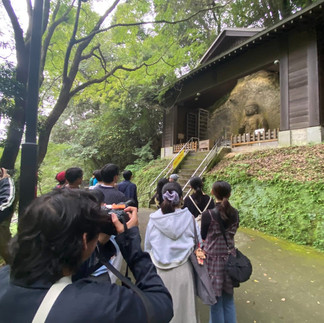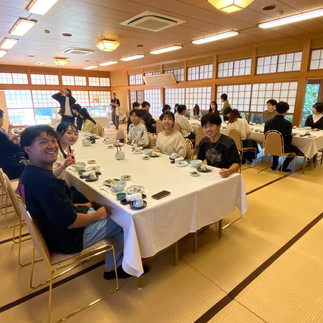Usuki City and Rikkyo University: Co-Creating New Value through Cultural Immersion
- Metasophia Info
- 10月27日
- 読了時間: 3分
On October 25–26, twenty students from Rikkyo University’s College of Tourism visited Usuki City for a two-day fieldwork program themed “Creating New Value in Usuki.” Through hands-on experiences and meaningful local encounters, the students explored the city’s cultural, historical, and gastronomic richness.
The program began with a guided tour of the Usuki Stone Buddhas, a National Treasure dating back to the late Heian period. A local guide provided engaging explanations of the Buddhas’ historical background, stylistic features, and key highlights, helping students appreciate their cultural and artistic significance.
Next, the group enjoyed a seasonal meal at USAMI Finefood and Cuisine, located near the stone Buddhas. The dishes featured “Honmamon” vegetables—grown in Usuki’s organic soil—and showcased the essence of the city’s UNESCO-recognized food culture.
The students then visited the Usukiyaki pottery studio, where they learned about the revival of this once-lost ceramic tradition. Mr. Hiroyuki Usami, head of the Usukiyaki Lab, shared the history of Usukiyaki, which originated during the Edo period under the Inaba clan, and explained how it was brought back to life through local craftsmanship.
At the Usuki Compost Manufacturing Center, staff introduced the city’s “Usuki Yume Compost,” made from 80% plant matter and 20% pig manure, fermented over six months. This natural compost supports the cultivation of Honmamon vegetables. Students also sampled a unique local okra variety called Star of David, known for its crisp texture.
The group explored Furen Limestone Cave, a 500-meter-long nationally designated natural monument. The cave maintains a constant temperature year-round, acting as a natural air conditioner—cool in summer and warm in winter. At its deepest point, the pristine white crystal formations evoked the image of the Pure Land paradise, leaving many students breathless.

At Fundokin Shoyu, students encountered the world’s largest wooden soy sauce barrel, measuring 9 meters in height and diameter, with a capacity of 540 kiloliters. Recognized by Guinness World Records in 2007, the barrel symbolizes Usuki’s deep-rooted fermentation culture—another pillar of its UNESCO designation. The soy sauce brewed in these barrels is shipped only once every four years—truly, the Olympics of soy sauce.
On the way back to the city center, students experienced Shichiyohi, a spiritual prelude held one week before Usuki’s Takeyoi Festival At Yasaka Shrine, bamboo lanterns and symbolic installations illuminated the grounds. The students were mesmerized by the ethereal glow and the quiet magic of the evening.
That night, the group enjoyed a local seafood dinner at SATOYA, featuring Usuki’s famed catch: horse mackerel, tuna, shrimp, octopus, cutlassfish, lizardfish, shark—and of course, Usuki’s signature delicacy, fugu (pufferfish). The students indulged in an unforgettable feast of local seafood from Usuki.
The following day, students visited the Former Residence of the Inaba Family, a prominent feudal clan that governed the Usuki domain during the Edo period. There, they learned about USUKI VENUE, a revitalization project that transforms historical architecture into unique event spaces.
At Kotegawa Brewery, they toured traditional facilities before tasting local sake and shochu. Since its founding in 1855, Kotegawa Brewery has preserved the art of handcrafted sake brewing. Rather than producing large volumes, the brewery focuses on refining flavor to meet diverse tastes.
Later, students split into four groups for independent exploration of the Haccho-oji shopping district, including areas affected by the November 2024 fire and the historic Nioza street. Some students even conducted interviews with residents.
Lunch was served at Kirakuan, one of Usuki’s three traditional ryotei. Students enjoyed local specialties such as Ohan (yellow rice colored with gardenia essence) and kirasu-mameshi (a mixture of fish scraps and tofu lees)—dishes rooted in Usuki’s culture of frugality and seasonality. Ms. Yamamoto, the proprietress, shared the restaurant’s history and the depth of Usuki’s culinary traditions.
The fieldwork concluded with a presentation session, where each group reflected on their experiences and shared ideas for enhancing Usuki’s appeal. A midterm presentation is scheduled for December 1, followed by a final proposal session on December 22, where students will offer concrete suggestions for the city’s future.
We look forward to seeing how their ideas will take shape—infused with the insights and inspiration gained through this immersive experience.





































































コメント